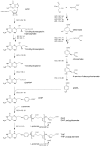Folate production by probiotic bacteria
- PMID: 22254078
- PMCID: PMC3257725
- DOI: 10.3390/nu3010118
Folate production by probiotic bacteria
Abstract
Probiotic bacteria, mostly belonging to the genera Lactobacillus and Bifidobacterium, confer a number of health benefits to the host, including vitamin production. With the aim to produce folate-enriched fermented products and/or develop probiotic supplements that accomplish folate biosynthesis in vivo within the colon, bifidobacteria and lactobacilli have been extensively studied for their capability to produce this vitamin. On the basis of physiological studies and genome analysis, wild-type lactobacilli cannot synthesize folate, generally require it for growth, and provide a negative contribution to folate levels in fermented dairy products. Lactobacillus plantarum constitutes an exception among lactobacilli, since it is capable of folate production in presence of para-aminobenzoic acid (pABA) and deserves to be used in animal trials to validate its ability to produce the vitamin in vivo. On the other hand, several folate-producing strains have been selected within the genus Bifidobacterium, with a great variability in the extent of vitamin released in the medium. Most of them belong to the species B. adolescentis and B. pseudocatenulatum, but few folate producing strains are found in the other species as well. Rats fed a probiotic formulation of folate-producing bifidobacteria exhibited increased plasma folate level, confirming that the vitamin is produced in vivo and absorbed. In a human trial, the same supplement raised folate concentration in feces. The use of folate-producing probiotic strains can be regarded as a new perspective in the specific use of probiotics. They could more efficiently confer protection against inflammation and cancer, both exerting the beneficial effects of probiotics and preventing the folate deficiency that is associated with premalignant changes in the colonic epithelia.
Keywords: Bifidobacterium; Lactobacillus; folate; gut; microbiota; probiotic.
Figures
References
-
- FAO/WHO. Human Vitamin and Mineral Requirements: Report of a Joint FAO/WHO Expert Consultation. Bangkok, Thailand. Chapter 4. FAO; Rome, Italy: 2001. Folate and folic acid; pp. 53–63.
-
- IOM. Dietary Reference Intakes for Thiamin, Riboflavin, Niacin, Vitamin B6, Folate, Vitamin B12, Pantothenic Acid, Biotin, and Choline. Chapter 8 The National Academies Press; Washington, DC, USA: 1998. Folate; pp. 196–305. - PubMed
-
- Fuchs C.S., Willett W.C., Colditz G.A., Hunter D.J., Stampfer M.J., Speizer F.E., Giovannucci E.L. The influence of folate and multivitamin use on the familial risk of colon cancer in women. Cancer Epidemiol. Biomarkers Prev. 2002;11:227–234. - PubMed
-
- Sellers T.A., Kushi L.H., Cerhan J.R., Vierkant R.A., Gapstur S.M., Vachon C.M., Olson J.E., Therneau T.M., Folsom A.R. Dietary folate intake, alcohol, and risk of breast cancer in a prospective study of postmenopausal women. Epidemiology. 2001;12:420–428. - PubMed
-
- Terry P., Jain M., Miller A.B., Howe G.R., Rohan T.E. Dietary intake of folic acid and colorectal cancer risk in a cohort of women. Int. J. Cancer. 2002;97:864–867. - PubMed
Publication types
MeSH terms
Substances
LinkOut - more resources
Full Text Sources
Other Literature Sources
Medical


